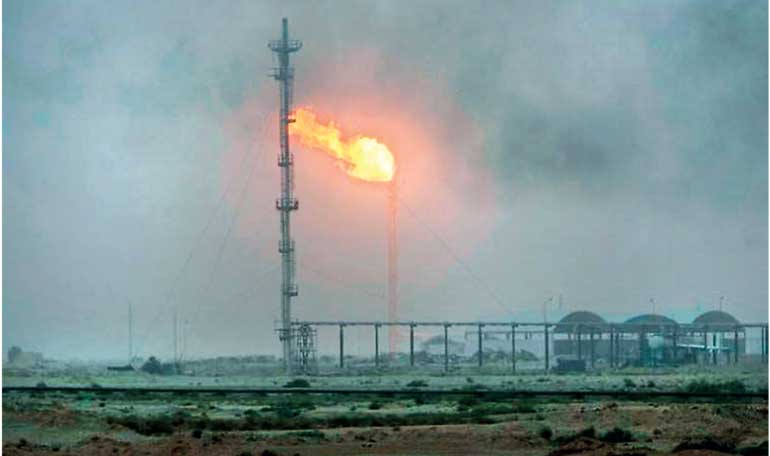Wednesday Feb 12, 2025
Wednesday Feb 12, 2025
Tuesday, 11 October 2016 00:05 - - {{hitsCtrl.values.hits}}

Flames emerge from a pipeline at the oil fields in Basra, southeast of Baghdad, September 30, 2016. REUTERS/Essam Al-Sudani
SINGAPORE (Reuters): Oil prices fell on Monday over doubts that an OPEC-led plan to cut output would rein in a global oversupply that has dogged markets for over two years.
Brent crude futures were trading at $51.58 per barrel at 0646 GMT, down 35 cents or 0.67%, from their last settlement.
U.S. West Texas Intermediate (WTI) futures CLc1 were down 39 cents or 0.78%, at $49.42 a barrel.
The Organization of the Petroleum Exporting Countries (OPEC) plans to agree on an output cut by the time it meets in late November. The targeted range is to cut production to a range of 32.50 million barrels per day (bpd) to 33.0 million bpd.
OPEC’s current output PRODN-TOTAL stands at a record 33.6 million bpd.
To achieve such an agreement among its members, some of which like Saudi Arabia and Iran are political rivals, OPEC officials are embarking on a flurry of meetings in the next six weeks, starting in Istanbul this week.
However, analysts cautioned about too high expectations about the Istanbul talks this week.
“A meeting between OPEC and non-OPEC producers (namely Russia) will add to oil headlines this week. Don’t expect a firm agreement from Russia, but headlines about cooperation are likely,” Morgan Stanley said on Monday.
“It’s also worth noting that Iraq and Iran oil ministers will not be in attendance,” the U.S. bank added. Even if a deal is reached, analysts are unconvinced it would result in much higher prices as the announced cuts aren’t deep and there are doubts over the feasibility of a cut among rivaling members, a Reuters poll showed on Friday.
Pouring cold water on expectations, OPEC’s second biggest producer Iraq said over the weekend that it wants to raise output further in 2017.
“Even with the apparent ‘cut’ that was agreed, we are still in an oversupplied market... (and) with the US rig count seeing an increase of 35 percent since May 2016 we are in real danger of being on the edge of another big correction,” said Matt Stanley, a fuel broker at Freight Investor Services in Dubai.
“Since its trough on May 27, 2016, producers have added 112 (+35 percent) oil rigs in the U.S.,” U.S. bank Goldman Sachs said.
Despite Monday’s dip, some analysts said they expected slightly higher prices going forward.
Barclays Bank said that it expected “stockdraws during the upcoming winter season will support physical oil... irrespective of any decision in November in Vienna. We expect that prices will rise to the low $50 per barrel range in Q4.”
Discover Kapruka, the leading online shopping platform in Sri Lanka, where you can conveniently send Gifts and Flowers to your loved ones for any event including Valentine ’s Day. Explore a wide range of popular Shopping Categories on Kapruka, including Toys, Groceries, Electronics, Birthday Cakes, Fruits, Chocolates, Flower Bouquets, Clothing, Watches, Lingerie, Gift Sets and Jewellery. Also if you’re interested in selling with Kapruka, Partner Central by Kapruka is the best solution to start with. Moreover, through Kapruka Global Shop, you can also enjoy the convenience of purchasing products from renowned platforms like Amazon and eBay and have them delivered to Sri Lanka.
Discover Kapruka, the leading online shopping platform in Sri Lanka, where you can conveniently send Gifts and Flowers to your loved ones for any event including Valentine ’s Day. Explore a wide range of popular Shopping Categories on Kapruka, including Toys, Groceries, Electronics, Birthday Cakes, Fruits, Chocolates, Flower Bouquets, Clothing, Watches, Lingerie, Gift Sets and Jewellery. Also if you’re interested in selling with Kapruka, Partner Central by Kapruka is the best solution to start with. Moreover, through Kapruka Global Shop, you can also enjoy the convenience of purchasing products from renowned platforms like Amazon and eBay and have them delivered to Sri Lanka.